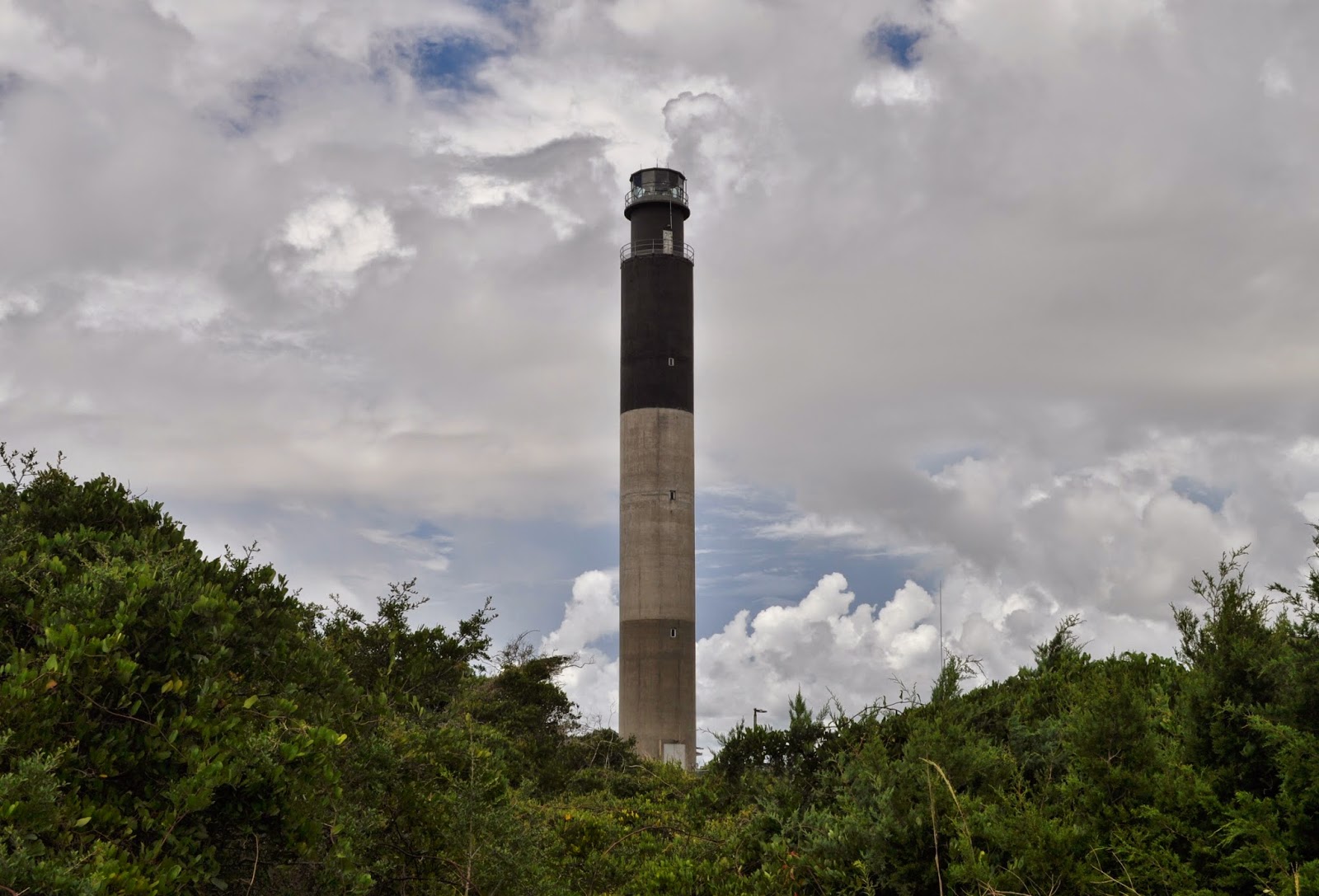The entrance to Cape Fear River is bounded by Bald Head Island on the east and Oak Island on the west. North Carolina's first lighthouse was completed on Bald Head Island in 1794 to mark the entrance, but due to erosion, it had to be replaced in 1817 by the current Bald Head Lighthouse, built a mile farther inland. Oak Island Lighthouse is an intriguing mixture of old and new, tradition and innovation. The present structure, completed in 1958, is one of the most recent lighthouses built on American shores. Although the current lighthouse is young, attempts to illuminate this particular stretch of water have been made for over two hundred years. These efforts have been thwarted by hurricanes, war, and changing shipping channels. In 1903, the Lighthouse Board built the 150-foot-tall Cape Fear Lighthouse a few miles west of Bald Head Lighthouse. Outfitted with a first-order Fresnel lens, the lighthouse produced a powerful flashing light to warn mariners away from the dangerous Frying Pan Shoals. Cape Fear Lighthouse served as the area’s coastal light until 1958, when an even more powerful light was installed atop a new tower constructed on Oak Island. As the last lighthouse built in North Carolina, Oak Island Lighthouse is as durable as they come. Twenty-four concrete-filled pilings were driven sixty-seven feet into the ground to provide a solid foundation, and an octagonal concrete base, measuring thirty feet wide and three feet deep, was used to cap the pilings. The tower itself stands 158 feet tall and is made of solid, eight-inch-thick, reinforced concrete. During construction of the tower, a temporary concrete mixing plant was set up at the site and operated continuously for six days. The concrete was poured into a movable form that was slowly raised by jacks at the rate of one foot per hour. When the project was submitted for bids, a tapering tower built of experimental aluminum-alloy panels was one of two potential designs, but the concrete tower with a constant diameter of seventeen feet won out.The three bands of color that give the tower its distinctive daymark also speak of modern innovation and durability. For the first forty feet of the tower, workers poured natural gray cement. In forming the next fifty feet they used a mixture of white Portland cement and white quartz aggregate, and for the final fifty feet they mixed black coloring with the cement. The result is a monolithic tower with three bands that never need repainting.Unlike traditional lighthouses, Oak Island Lighthouse has no spiral staircase. Instead, its keeper had to climb a series of ships ladders with a total of 134 steps. Tools are hauled to the top in a metal box attached to a long pulley. The aluminum lantern room, which now houses four 1000-watt aerobeam lights, weighs 1,740 pounds and had to be installed by a Marine Corps helicopter. With its 2.5 million candlepower lights flashing intermittently and visible twenty-four miles out to sea, Oak Island Light is one of the most powerful lighthouses in existence. On May 15, 1958, eighty-five-year-old Captain Charles N. Swan, who was born at Amelia Island Lighthouse, served aboard Frying Pan Shoals Lightship, and was keeper of Cape Fear Lighthouse on Bald Head Island from 1903 to 1933, threw the switch to activate Oak Island Lighthouse. Twenty minutes after its activation, the light went out, but a fuse was quickly replaced, and the beacon was back in operation before darkness fell.In the 1930s, the U.S. Coast Guard took ownership of the land on which Oak Island Lighthouse is located and used a portion of the property for a Coast Guard station. However, in 2004, both the Oak Island Lighthouse and the land immediately surrounding the tower were deeded to the town of Caswell Beach. A non-profit organization, Friends of Oak Island Lighthouse, has been formed to preserve and maintain the lighthouse and grounds. The Coast Guard still is in charge of maintaining the lights, but the public is able to climb the lighthouse through tours arranged through Friends of Oak Island Lighthouse. If that sounds like too much work, the town has constructed a boardwalk and an observation deck just across the street that provide a great view of the lighthouse.
Oak Island Lighthouse in 1962
Photograph courtesy U.S. Coast Guard
Photograph courtesy State Archives of North Carolina








No comments:
Post a Comment